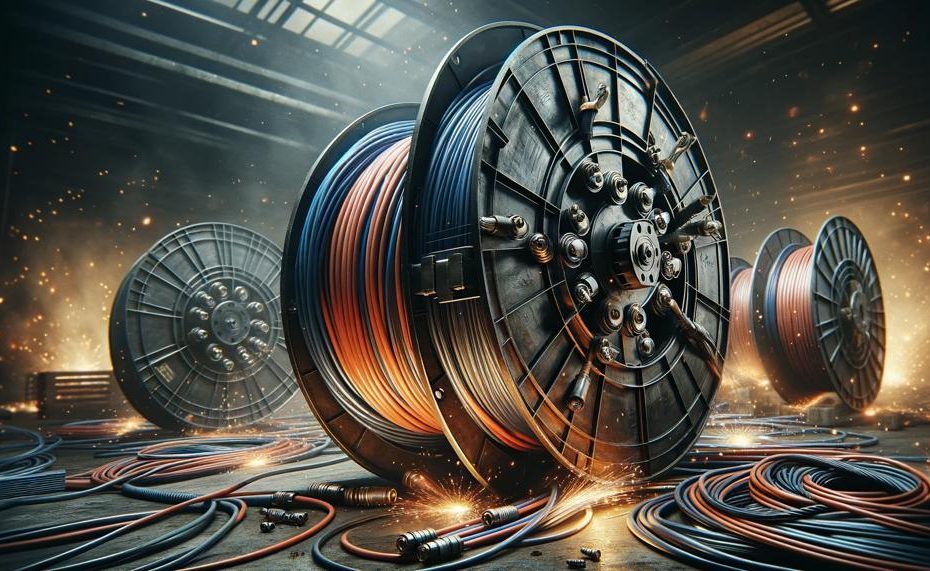Welding cable reels are essential for ensuring a well-organized, secure, and productive work environment. These indispensable equipment not only assist in the management of the unwieldy lengths of welding wires but also play a key role in prolonging the lifespan of the cables by reducing kinks, twists, and wear.
Creating your own welding wire reel may be a fulfilling endeavor, providing a personalized solution designed to meet your unique requirements and workplace.
In this guide, we’ll walk you through the process of building a durable and functional welding cable reel. From gathering the right materials to assembly tips that ensure longevity and ease of use, we’ve got you covered. Here’s a sneak peek into the key points we’ll explore:
- Selecting Materials: Choosing the right materials for durability and functionality.
- Design Considerations: Tailoring the design to fit your workspace and cable management needs.
- Assembly Tips: Step-by-step guidance to ensure a smooth assembly process.
- Maintenance Advice: Keeping your reel in top condition for years to come.
Whether you’re a seasoned welder looking to enhance your workspace or a hobbyist taking on a new project, this guide promises to equip you with all you need to create an efficient and robust welding cable reel.
Contents
What Materials and Tools Do You Need to Make Welding Cable Reels?
Crafting a welding cable reel yourself is a savvy way to keep your cables organised and ready for action. Here’s a straightforward guide on the essential materials and tools you’ll need, ensuring your welding projects run as smoothly as silk.
| Material/Tool | Description | Usage |
| PVC pipe or wooden dowel | Core structure for the reel. | To roll and store the welding cable. |
| Plywood or MDF board | Sturdy base material. | Forms the structural base of the reel. |
| Screws | Fastening material. | To assemble the core and base together. |
| Drill | Power tool for making holes. | For drilling holes to fit screws and assembling parts. |
| Wire cutters | Tool for cutting metal. | To trim and adjust the cable length if necessary. |
| Metal hose clamp or zip ties | Securing devices. | To secure the cable onto the reel firmly. |
| Electrical tape | Insulating tape. | For additional protection and insulation of cable ends. |
| Optional casters or handles | Mobility enhancements. | For easy transportation of the reel around the workshop. |
| Proper amperage rating welding cable | High-quality cable for welding. | To ensure compatibility with welding machines. |
| Gauge size cable | Based on amperage requirements. | To match the specific needs of your welding projects. |
Armed with these materials and tools, you’re set to craft a welding cable reel that’s not just functional but tailored to your welding needs. Remember, the key is in choosing the right gauge size and ensuring the cable’s amperage rating is a match with your welding machine. This DIY project not only saves you from the hassle of untangling wires but also keeps your workspace neat and organised.
Step-by-Step Guide to Making a Welding Cable Reel
Here’s what you’ll need to craft your very own welding cable reel, a nifty contraption that’ll keep your space tidy and your wires in check:
| Materials | Tools | Optional |
| PVC pipe or wooden dowel | Drill | Paint or varnish |
| Plywood or MDF board | Wire cutters | Casters or handles |
| Screws | Metal hose clamp or zip ties | Connectors or fittings for welding machine |
| Electrical tape |
Gather these bits and bobs to set the stage for a reel that’s not only effective but can also have a touch of your personal style with optional paint or varnish. Consider slapping on some casters or handles to make your reel mobile, and ensure you’ve got the right connectors or fittings to match your welding machine.
How Do Welding Lead Reels Work?
Welding lead reels are crafty devices, designed with both grit and wit, to manage and protect the welding leads – those vital lifelines of the welding world. With their spools as sturdy as the hands that work them, these reels come in different breeds: some are manual, beckoning for a turn of the hand, while others hum to the tune of motors, spinning effortlessly.
Purpose and Mechanism
The essence of a welding lead reel lies in its dual mission: organizing the chaotic sprawl of welding leads and shielding them from the rough and tumble of the workshop.
This choreography of convenience and safety not only tidies the workspace but also wards off hazards, ensuring that the dance between metal and flame proceeds without a hitch.
The Anatomy of Operation
Welding lead reels sing a song of simplicity and efficiency. Here’s a glance at their inner workings through a table, offering a peek into their skeletal structure:
| Feature | Function | Benefit |
| Spool | Holds the welding lead | Reduces tangles and wear |
| Manual or Motorized Mechanism | Winds the lead onto the spool | Offers ease of use and adaptability |
| Durable Materials | Protects the lead | Ensures longevity and safety |
In the spirited world of welding, crafting your own lead reel is a testament to skill and ingenuity. With some basic welding know-how and a dash of carpentry, one can forge a reel that not only meets the unique demands of their projects but also saves a penny or two in the long march of time.
Safety, as always, takes the spotlight in this endeavour, guiding the hands that build and maintain these reels.
How Many Amps Can Welding Cable Handle?
The maximum amperage capacity of welding cables varies, primarily influenced by the cable’s diameter (AWG size), the material of the conductors (usually copper), the length of the cable, and the ambient temperature conditions.
These factors directly impact the construction and design of welding cable reels, ensuring they accommodate the specific needs of welding tasks while prioritizing safety and efficiency.
Understanding Ampacity:

The concept of ampacity is central to selecting the right welding cable. It ensures the welder operates effectively without risking damage to the cable or creating a safety hazard. The table below showcases typical ampacity ratings for various AWG sizes of welding cables, considering an ambient temperature of 25°C and a standard 60% duty cycle, which is common in welding operations:
| AWG Size | Ampacity (Amps) | Typical Applications |
| 0 (1/0) | 150-170 | Heavy-duty welding |
| 2 | 125-145 | General welding |
| 4 | 100-125 | Light to medium welding |
| 6 | 85-105 | Light welding |
How Many Amps Will 2 0 Welding Cable Carry?
The maximum amount of amps a 2 0 welding cable can safely carry depends on several factors, including the ambient temperature, the length of the cable, and the specific application. However, as a rough guide, a 2 0 welding cable is typically capable of handling up to 190 to 200 amps in most circumstances.
This capacity ensures that the cable can manage a high level of current without overheating, making it suitable for a variety of welding tasks.
To offer a clearer understanding, here’s a breakdown in table format, illustrating how ambient temperature affects the current-carrying capacity of a 2 0 welding cable:
| Ambient Temperature (°C) | Current-Carrying Capacity (Amps) |
| 30 | 200 |
| 40 | 195 |
| 50 | 190 |
It’s key to remember, the cooler the environment, the higher the current the cable can carry without risking damage or safety hazards. This capacity might diminish slightly in hotter conditions due to increased resistance and potential for overheating.
What Gauge Is Welding Cable?
Welding cable, a critical component in the arsenal of any welder, boasts a construction of fine copper strands sheathed within a robust jacket, ensuring both flexibility and durability.
The heart of the matter lies in selecting the appropriate gauge, a decision guided by the cable’s ampacity – its capacity to convey current safely without succumbing to overheating or compromising the integrity of its insulation.
Standard Gauge for Welding Cable
The American Wire Gauge (AWG) system, a standard since 1921, serves as the yardstick for determining cable size. The standard gauge for welding cable varies, as it is contingent upon the welder’s amperage and length requirements.
However, a range commonly used spans from 6 AWG for lighter applications, up to 4/0 AWG for heavy-duty demands, ensuring a broad spectrum to cater to diverse welding needs.
Importance of Gauge Selection
Selecting the right gauge for welding cable reels is paramount for several reasons:
- Safety: A cable that’s too thin may overheat, posing a fire hazard or damaging the insulation.
- Performance: Adequate gauge ensures optimal current flow, crucial for efficient and effective welding operations.
- Durability: Correctly sized cables resist wear and tear better, extending their service life.
Insightful Table: Welding Cable Gauge Selection
| Welding Amperage | Cable Length (Feet) | Suggested AWG |
| 100-150 Amps | 50-100 | 8 AWG |
| 150-200 Amps | 50-100 | 6 AWG |
| 200-300 Amps | 50-100 | 4 AWG |
Conclusion
Starting to make your own welding wire reel will not only make your area more organized, but it will also let you make it exactly how you want it. To start, you need to choose high-quality materials and know exactly what your welding jobs call for. This will make sure that the end result is long-lasting and exactly what you need. The step-by-step instructions give you a plan for making a welding cable reel that will keep your welding wires in order and protect them, making your office run more smoothly.
Looking at different materials, like the core structure and the insulated tape, along with the necessary tools, makes sure that there is a base for a project that both new amateurs and experienced welders can understand. This guide shows you how to make a reel that not only does its job but also lasts for a long time by talking about the important things you should think about when designing and putting it together.
The parts of welding lead reels, how they work, and important facts about the amplifying power of welding wires show how important it is to combine scientific information with real-world use. This combination not only makes welding wires last longer, but it also speeds up the work process in any welding job.
To put it simply, making your own welding wire reel shows how creative and useful you can be.





